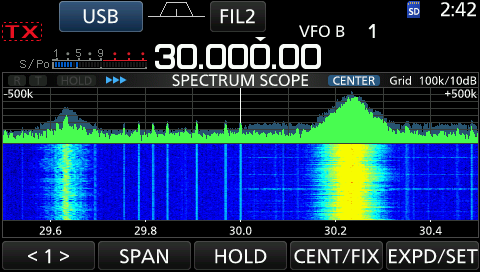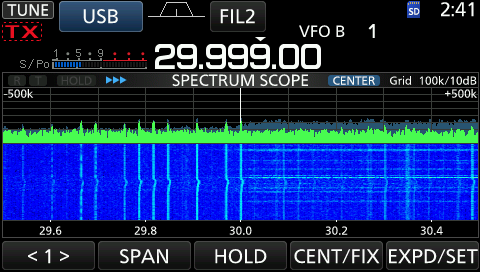The analog to digital converter in the IC-7300 is rumoured to be the LTC2208-14. This converter supports sample rates up to 130 MHz. This implies a max receive frequency in the first Nyquist zone of fs/2=65 MHz. So how can the IC-7300 receive on the 4m band then?
Actually this was one of the first questions I had when reading about the IC-7300 and the ADC used. It looked like I was the only one wondering about it and so I moved on, until….
Until I hooked up the antenna on my new location and tuned across the bands, 29 Mhz, 30 , 31. Wow, many very strong wide band FM signals above 30 Mhz. Nobody is using those analogue cordless phones anymore, so WTF:

Are these real signals? No, because I don’t hear them on my TS-2000 and they are gone when I tune just below 30MHz, even with the scope set to a wide range that covers above 30 Mhz. Note that when tuning below 30 Mhz, different band filters are selected.

Since the signals sounded (and looked) like FM broadcast, I compared the strongest one to Radio Bremen on 93.8 MHz. Guess what, Radio Bremen appeared on 30.232 MHz on my IC-7300. Just to verify, I took a small FM broadcast receiver and listened to both. Clearly the audio contents, like rhythm and so on, were the same. On the IC-7300, the FM bandwidth is far too small to properly decode broadcast speech or music.
The very strong FM broadcast station at 93.800 is creating an alias at 30.232 MHz. This implies a 93.800 + 30.232 = 124.032 Mhz sampling frequency. This matches perfectly with the IC-7300 schematic: X1201/CR-932 runs at 41.344 MHz, times 3 makes 124.032. Also the DACLK signal going into the DAC (for TX) is labelled with 124.033 MHz (IC-7300 Service Manual, Block Diagram, Main Unit). It looks like the IC-7300 switches to some wide filter when tuned above 30 Mhz resulting in bad alias rejection.
The new IC-9700 actively uses the principle of higher Nyquist zones (aka band limited sampling) to receive far above the ADC sample frequency. Here proper anti-alias filtering is required to avoid receiving on alias frequencies. This also explains why the IC-7610 does not receive on 70 MHz, since this trick to receive frequencies above Fs/2 is sub optimal, and therefor not suited for the high-end IC-7610. (my take on Icom’s design decision..) I’m now gonna dig up my decades old 30 MHz lowpass filter…
PS.: A good practical explanation of band limited sampling and aliasing can be found here. This text is understandable even if you skip the math on delta function, convolution and Fourier transform.
I guess that’s why Icom specified “guaranteed” coverage only up to 30 MHz, then 50-54 MHz. BTW any chance your 7300 has the “MARS-mod”? I came here because a buddy just bought a MARS-modded 7300 (aka “the most popular CB ever”) and he also noticed images/aliasing from the FM band on 30-34MHz. We were wondering if there’s a connection.
Hi,
I’m pretty sure this has nothing to do with MARS mod. My 7300 does not have the MARS mod. If you put a 30MHz lowpass filter in line, the images will be gone.
Best 73,
Frank
Hi
Measurements as taken on my stock standard ICOM IC-7300 Receiver Measurements on 18.11.2021
RX Freq mute Spurious mute Diff
MHz dBm MHz dBm dB
27.033 -128.8 97.000 -31.4 -97.4
28.033 -125.0 96.000 -30.1 -94.9
29.033 -125.7 95.000 -117.8 -7.9
30.033 -126.3 94.000 -109.4 -16.9
31.033 -124.2 93.000 -108.9 -15.3
32.033 -122.5 92.000 -108.1 -14.4
33.033 -125.6 91.000 -112.7 -12.9
34.033 -125.1 90.000 -113.8 -11.3
35.033 -125.0 89.000 -114.1 -10.9
36.033 -125.8 88.000 -116.1 -9.7
37.033 -126.0 87.000 -116.1 -9.9
38.033 -126.0 86.000 -117.2 -8.8
39.033 -126.0 85.000 -117.8 -8.2
40.033 -126.1 84.000 -118.6 -7.5
41.033 -125.8 83.000 -119.1 -6.7
42.033 -125.6 82.000 -119.2 -6.4
43.033 -125.6 81.000 -120.6 -5.0
44.033 -125.6 80.000 -120.5 -5.1
45.033 -126.9 79.000 -121.7 -5.2
46.033 -125.7 78.000 -120.9 -4.8
47.033 -125.9 77.000 -121.1 -4.8
48.033 -125.5 76.000 -121.3 -4.2
49.033 -124.9 75.000 -120.6 -4.3
50.033 -124.9 74.000 -72.0 -52.9
51.033 -125.3 73.000 -81.3 -44.0
52.033 -125.4 72.000 -87.5 -37.9
53.033 -125.4 71.000 -92.7 -32.7
54.033 -125.2 70.000 -123.0 -2.2
55.033 -125.1 69.000 -122.6 -2.5
56.033 -124.5 68.000 -123.1 -1.4
57.033 -124.5 67.000 -123.2 -1.3
58.033 -124.2 66.000 -123.3 -0.9
59.033 -123.7 65.000 -123.2 -0.5
60.033 spurious 64.000 spurious n/a
61.033 -123.7 63.000 -123.7 0.0
FM mode, mute opening used as reference point.
Spurious frequency rejection on some frequencies as can be seen is almost not existent.
73s
Igor
Hi Igor,
Many thanks for your measurements.
The effect of the 10m and 6m band filters is quite clear. Interesting is your 3rd measurement, 29.033. My 7300 switches filters at 30.000. Below 30.000, the aliases (FM band) are low. I would expect here a result like the 1st and 2nd measurement.
Best 73
Frank